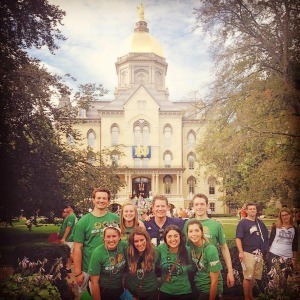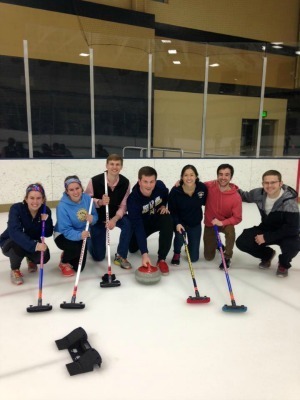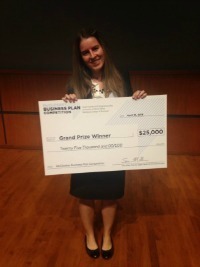I definitely wasn’t alone in having some trouble explaining to family members, friends, and potential employers exactly what Notre Dame’s ESTEEM program really was. Thanks to a rather misleading acronym, the Master’s program invoked a whole lot of “huhs?” from curious individuals (whose guesses ranged from “is it like an MBA?” to “are you in a self-help program?”). Though by the end of the first semester I had developed a quick, cohesive explanation to describe the technology commercialization aspect of the program, I always felt that my elevator pitch was quite wanting. How do you pack eleven months of hard work, friendships, opportunities and emotions into a thirty second spiel? Entrepreneurship curriculum aside, here would be my shortlist of the elements that make ESTEEM, ESTEEM:
ESTEEM is….
Building Bridges
And not just the physical ones (but here’s looking at you, Christian, and all the other past Civil Engineering majors). Since I hail from Pittsburgh, the city of bridges, it’s no surprise that these physical links have inspired me to develop strong interdisciplinary connections. This program has pushed all of us out of our comfort zones and allowed us to use our individual backgrounds (whether it be from a life science, engineering, or even religion studies background) to develop an entirely new skill set. For example, our past laboratory analysis skills were put to good use in our Data Analytics course, where we sifted through 6 million cells of Indiana crash data to look for patterns and suggest reasonable changes to the State Police. Years of reading scientific journals helped ease the pain of the comprehensive literature search required for our first thesis chapter, and experience in modeling software helped us to develop sophisticated financial models in Excel. The curriculum expanded upon our technological acumen to open up a world of business and entrepreneurial skills, and provided an avenue to help each other when our expertise ran short (i.e. Thank you Joe and Stephen for helping me through the IT course and preventing me from crashing my computer!).

More importantly, however, the program allowed me to develop connections with 38 capable, unique and talented individuals who simply made my year in ESTEEM the best year of my life. These people aren’t just my classmates, but my teammates, future business partners, and good friends. We’ve nervously approached strangers to interview for BMC together, driven around the West Side of town searching frantically for a Spanish-speaking bank teller for Design Entrepreneurship together, burned the midnight oil in Innovation Park together and sung along to our favorite song, “Gasolina,” at the Backer together (even though none of us know the words). Our common experiences, similar sparks of curiosity and drive for excellence have challenged each other to do our best and act as our brothers’ and sisters’ keepers when times were tough. Even though we may forget all of the elements that go into a Business Model Canvas or the difference between debits and credits in the next few years, our strong bonds will always be here to stay.
Learning to say YES to everything….

Coming to ESTEEM and plunging into the world of entrepreneurship was an interesting culture shock as a biochemistry major. The fast-paced, seemingly overconfident world of business seemed rather unapproachable to the students who had spent years in the slower, evidence-heavy technical fields that abhorred strong words such as “prove.” ESTEEM was a wonderful chance to throw caution into the wind and just say “yes” to whatever opportunities rolled our way. Join a McCloskey team committed to developing your thesis into a real startup? Yes! Go to Las Vegas to present your Data Analytics class findings at the SAP TechEd conference? Sure! Start an ESTEEM curling team when no one has any experience? Why not? (I’ll have you know, we made it up to the 2nd round of playoffs). As a class of self-starters, we all truly made the most of our time at Notre Dame, and many of our skill sets were developed outside of the curriculum. Courses such as Design Entrepreneurship introduced us to the art form of rapid prototyping, which encouraged us to brainstorm and throw out any of our ideas, no matter how silly or strange. As our business skills developed and our theses took shape, all 39 of us metamorphosed into confident and analytical students eager to share our opinions and ideas. By the end of the year the BMC interviewing and business networking jitters were a thing of the past, and dynamic presentations overshadowed our now-famous nervous 3-minute thesis presentations at the end of the summer. Though we’ll probably never stop rolling our eyes when we hear Sunny say “get out of the building,” I know we are always grateful for his advice.
While encountering a whole lot of “NOs”

During the course of the year, we heard “Fail fast, fail often” quite a few times. Though many people focus on the opportunities and “yes” moments of entrepreneurship, the ESTEEM program doesn’t neglect to remind you that starting a business can be incredibly difficult. From personal experience, I’ve experienced a lot of “NOs” when developing my thesis project, Certus Therapeutics, which was the subject of an Office of Technology Transfer business plan team. The five of us put in at least 20 hours of work per week from September to April, created over fifteen iterations of our business plan and slide deck, and attended three separate business plan competitions. Through interacting with over 60 investors, VCs, and entrepreneurs, we heard more “NOs” than we had ever heard in our life. But instead of trudging home in defeat, we reacted swiftly, talking with judges to understand their opinion, reevaluating our pitch deck focus, and working tirelessly to improve our offering. After months of work, it truly paid off, with demonstrated interest in the venture by biotech VCs as well as a grand prize win in Notre Dame’s own McCloskey Business Plan Competition. We’ve all experienced setbacks and changes (“pivots,” as we call them) in our theses, class projects, and even our career aspirations. ESTEEM has allowed us to understand the importance of these “NOs” and learn from these occurrences, which makes the “yes” moments so much sweeter.
Though I have done a successful job of talking the ears off my family, friends, and professional contacts discussing the merits of the ESTEEM program, I don’t think I’ll ever find the words (or the time) to truly encapsulate the gratitude I have for learning so much about business and entrepreneurship, working under the guidance and support of Sunny, David, and Rebekah, and spending a year with the most amazing people I’ve ever met. I think for now, I can only smile. Love thee ESTEEM, and love thee Notre Dame.
